If you’re reading this article, you probably were just gifted with an orchid, and you aren’t quite sure what kind of orchid it is, much less how to take care of it. If it was a gift, present, or a splurge on a regular grocery store adventure, now you have an orchid to take care of. Not sure what to do? Don’t worry! We all were there at one point. In this guide, I’ll walk you through the steps of how to keep this gift beautiful.
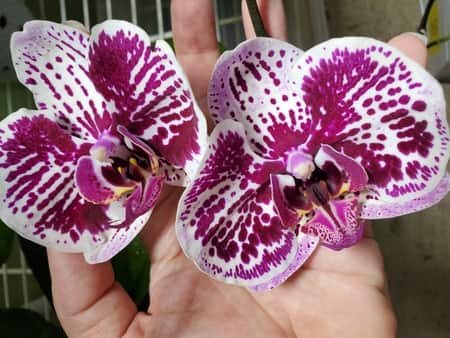
Beautiful as a gift, but what kind of orchid is this?
The most gifted orchids are called Phalaenopsis (Fahl-ley-NOP-sis), or moth orchids. They received this name because explorers walking through dense tropical forests at first thought these orchids were white butterflies–or moths–flying around among the thick vegetation. At a second glance, they discovered they were, in fact, flowers. I’ll talk more about that later.
There are typically two sizes of Phalaenopsis orchids: a small one that fits in a teacup called a mini Phalaenopsis, and a bigger one. The orchid you got is at it’s full, mature, adult size. It will not grow into a huge one if it is a mini-orchid. They come naturally in all colors – except the blue one (which, if that is your case, please read this other article I wrote on how to care for a blue orchid).
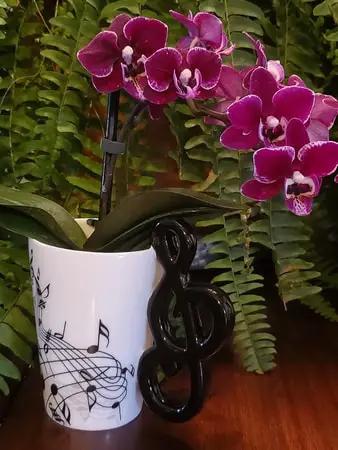
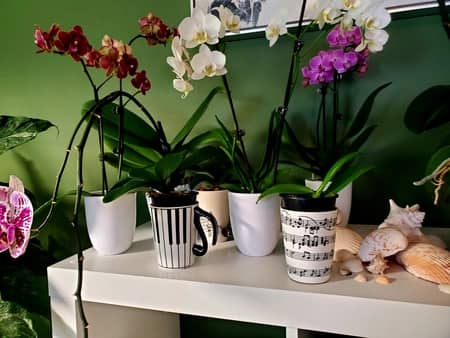
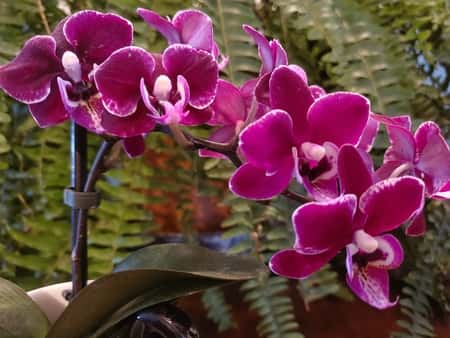
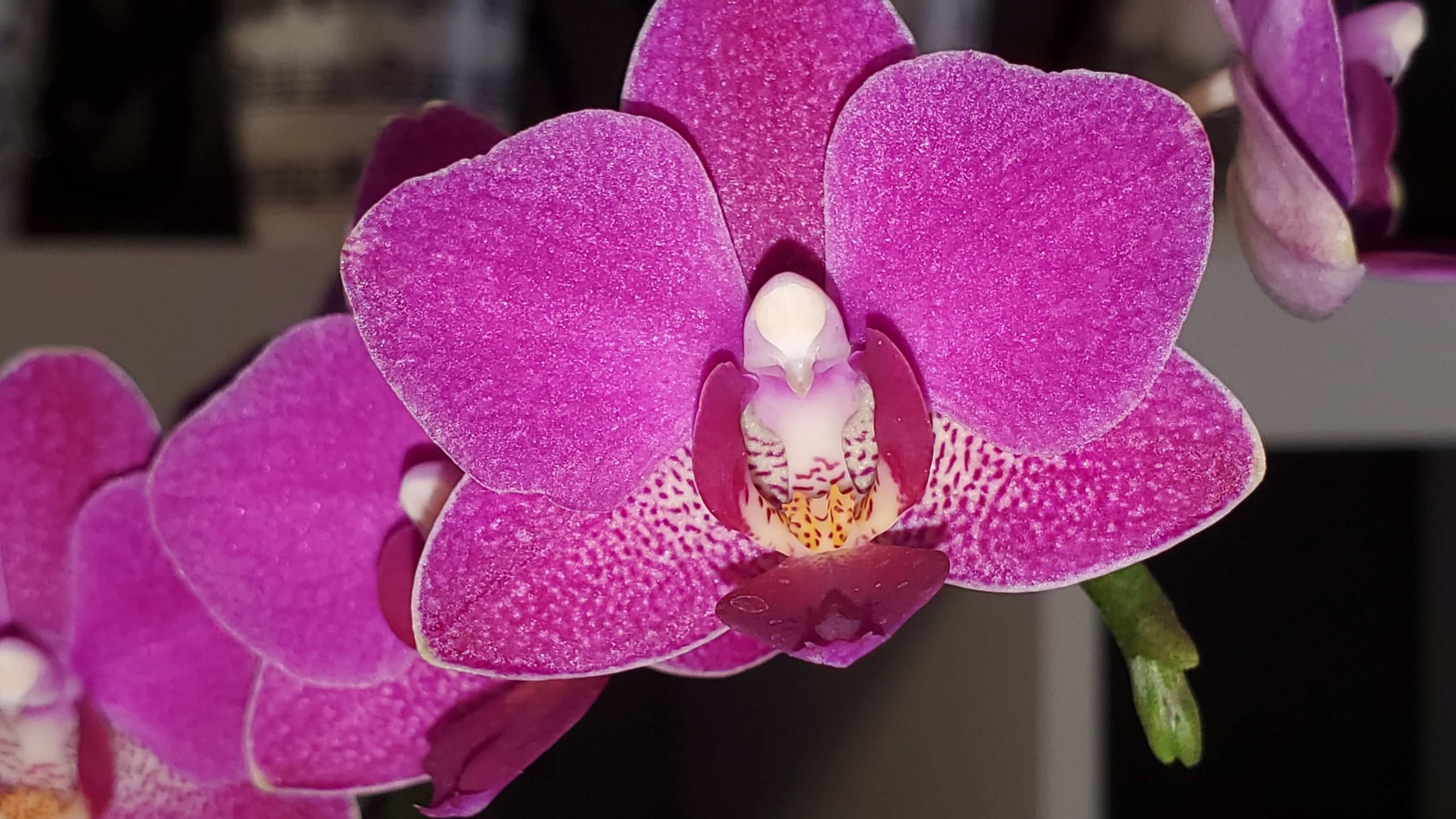
If your orchid is not like the pictures above, then you have another type, most likely a Cattleya. In any case, this guide will give you the basics of orchid care; it would be better to have a specific guide for the orchid you have. You can go to this page to identify your orchid or go straight to Cattleya Care.
Are Phalaenopsis easy to take care of?
Phalaenopsis orchids are no more complicated to care for than the common houseplant, rapidly growing to be one of the easiest orchids to take care of if you have the right information. Since Phalaenopsis are tropical plants, their care requires that you gather more information, and the more instruction and guidance you have about your orchid, the better off you’ll be.
Good news! You’re on the right track, and you’ve come to the right place. With this guide, you’ll have a complete understanding of how to care for your Phalaenopsis orchids as a beginner.
Soon, you’ll discover that caring for orchids is not as complex or complicated as you initially thought. They’re a bit easier in my opinion. It’s not only my opinion either. Just so you know I’m not making this up, here are a few other views from authoritative orchid growers:
- -Barbara Larson, Unit Educator at Horticulture Boone and Winnebago Counties, published an article for University of Illinois Extension
 , in which she stated that orchids are actually the easiest houseplants to grow if you meet the right condition;
, in which she stated that orchids are actually the easiest houseplants to grow if you meet the right condition; - Rob Halgren, research assistant professor in the Department of Animal Science at Michigan State University, also shares the same opinion that orchids are not hard at all. They are actually quite resistant and forgiving. You can read his overall care guide by clicking on the blue link.
- Dave Clement, a Ph.D., Extension Specialist in Plant Pathology and Mary Kay Malinoski, Extension Specialist in Entomology wrote this guide for the University of Maryland Extension
 , in which they state that cultivating Phalaenopsis is not difficult, as long as the specific care instructions are followed.
, in which they state that cultivating Phalaenopsis is not difficult, as long as the specific care instructions are followed.
So it’s not that Phalaenopsis Care is hard, but let’s get into the specific items of how to properly care for it so you can start your path to becoming an orchid addict. 🙂
What Does This Phalaenopsis Orchid Care Guide Cover?
For any orchid, you will need to grasp the 5 main topics listed below. They aren’t complicated, and I will walk you through them step by step. So, how do you care for your moth orchid? With information—good information.
- specific lighting preferences,
- humidity requirements,
- water routines,
- pH,
- and fertilization,
Phalaenopsis care and maintenance is all about correct information and applying it to your daily routine. We’ll get to each of these topics in this guide so you can adequately care for your moth orchid. But I’ll also throw in some interesting facts about Phalaenopsis along the way.
The more you know about where your orchid came from, where it lived in nature, how it traveled across oceans, and how it is now the number one-selling orchid, the better you’ll care for it.
Phalaenopsis History, Genealogy, and Background
Let’s explore the background of Phalaenopsis to understand where it came from and where it’s going (from the tropical rainforest in Southeast Asia to the best window sill in your home).
Orchids have had a bad reputation for a long time: hard to care for, complicated, won’t rebloom, die quickly, and expensive… But you’re about to discover that this information doesn’t measure up.
The love for keeping orchids indoors started in Europe as a show of wealth and prosperity. People could not grow orchids because of the cold weather and overcast skies. Orchids thrive in bright filtered light in tropical rainforests, so if you could adequately grow these plants, you were the top star. Maybe this is where they acquired the fame of being hard to grow? I’m not sure. The rest of the tropical world had these orchids as their backyard collections, but the climate allowed that.
Once the Wardian cases were built, which are a form of closed glass terrariums, orchids could be transported overseas and not die from the 6-week trip on a boat. This introduced orchids into the European botanical world, and from there, they spread across nations quickly.
So, where were these gorgeous orchids growing? Where are moth orchids found? Phalaenopsis grows naturally in Southeastern Asia, including the Philippines, Myanmar, Thailand, China, Malaysia, and Borneo.
These rich lands with tropical rainforests have a year-round climate of 74ᵒ to 91ᵒ F (23ᵒ to 33ᵒ C). Rain falls almost every day, and humidity levels remain constant at 70 to 90 RH (Relative Humidity). In these dense tropical forests, light doesn’t penetrate past the canopy of the leaves.
Filtered light will freckle the sides of trees at higher altitudes, but the average percentage of light that makes it through the leaves and to the soil is only 1%. That all translated means that it’s pretty dark near the forest floor. Contrary to popular belief, the soil is impoverished in nutrients. The nutrition comes through the air, floating from other pollinated flowers, rain-washed bark, and animals that transport minerals and nutrients as they travel on air currents through the tree branches.
Orchids “knew” that if they were going to survive, they’d have to get to the top of trees. They adapted over the years (thousands and thousands of years) to grow on tree bark. They aren’t parasites; they don’t feed off the tree in any way. They hold onto the tree for dear life.
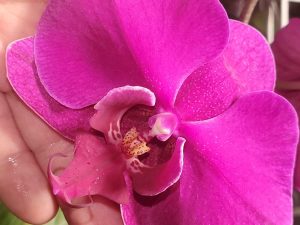
All Rights Reserved
Their seeds were made to travel on air currents, floating higher up as the wind took them. Once nestled into a cranny of the tree, orchids started to spread out roots that would tightly cling to the tree trunk.
Phalaenopsis would then spread out aerial roots that could grasp nutrients that floated through the air. This way, they wouldn’t have to depend on the soil beneath them to survive.
Where did the Phalaenopsis get its complicated name?
Phalaenopsis orchids were discovered in 1825 by Dr. C. L. Blume, a Dutch Botanist. Dr. Blume worked in Bogor (Java Island in Indonesia) as a botanist at the Royal Botanic Gardens.
While journeying through the rainforest, he saw huge white moths, almost angelic-like figures, playing around with the lush vegetation. As he approached, Dr. Blume realized these weren’t moths but Phalaenopsis orchids. The wind would play with the flower spikes, making them float effortlessly.
Dr. Blume names the orchid the moth orchid, which comes from the Greek words, “Phalaina”, which translates as moth, and “opsis”, which is resembling, in the likeness of, appearance.
The exact species he discovered was Phalaenopsis ambilis, which means charming.

Phalaenopsis in the Modern-day World
Since the moth orchid made its way to Europe, thanks to the air-tight, glass Wardian cases, they became accessible to the European market, yet for a precious price. These incredibly expensive plants charmed the aristocrats. Only the wealthy could afford a Phal (or any other for that matter), and the auctions and sales were for the upper class only.
Needless to say, these plants sold for tiny fortunes.
Money drives business. Orchids introduced a new form of life style: orchid hunters. The stories of these brave explorers are amazing to read as they cross uncharted lands to find new genera and species of orchids.
Phalaenopsis Culture and Marketing
How are Phalaenopsis orchids produced? With the advance of technology, seeds could be germinated in labs and in petri dishes, not having to rely on manual pollination. The availability went up; the prices came down. You can purchase an adult Phal for around US$ 15-20 and a miniature Phal for around US$ 8-10.
Phals became more accessible to plant lovers and spread like a fever across the continents, becoming the number one houseplant that is gifted after roses.
Phalaenopsis orchids have long outranked the Cattleya for the number one commercialized orchid. Cattleyas used to rank because of their high value in corsages and wedding bouquets. But Cattleyas stay in bloom for almost a month, maybe five weeks. Phalaenopsis triple that—3 months in bloom. If you’re lucky, it will bloom twice.
With constant genetic adaptations and tweaks to their hybrids, Phalaenopsis can blossom year-round (not the same plant, but different species inside the genus.) If you want a visual garden with blooms year-round, buy one blossoming Phalaenopsis each month. Next year, the blossoms will flower simultaneously, and you’ll have beautiful flowers in your indoor garden year-round.
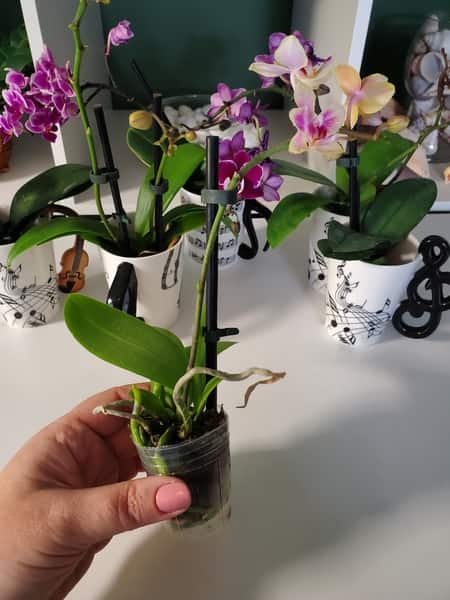
So, that’s all excellent news. But how do I care for my orchid?
To care for your Phalaenopsis orchid, you’ll have to recreate the natural environment that the moth orchid was in when they lived in the wild. Orchids are great houseplants, if you provide specific conditions they want to live in. This means regulating the temperature, humidity, sunlight, watering, and fertilization. If you get these 5 right, you’re orchid will live for over twenty years. If not, it might die after the first bloom, which, unfortunately, is the fate of many orchids.
Let’s take each of these points one by one:
1. Beginner Phalaenopsis Orchid Care: Lighting
Don’t ever place Phals in direct sunlight. They can’t tolerate direct sunlight on their leaves. Think back to the tropical rainforest. They are lodged in the nooks of trees, hidden beneath tree branches, and watered as the rain trickles down from the tree. The light is bright since they are high up in the canopy, but the leaves are still heavily shaded from the direct rays.
They love the brightness; they hate the direct rays.
This classifies them as low-light orchids. Don’t put them in the shade because they’ll die. But keep them on a window sill where they get morning or late evening sun. Never choose a window that has direct, hot rays during the hottest part of the day. South or east-facing windows are the best if you are in the northern hemisphere.
But before you place your orchid in a south window, look outside. Are there trees that block the sun? Is it always shaded? Is there a tall building that blocks not only your view but also the light rays? In these specific cases, another window might be better.
I had the unfortunate mishap of not getting good lighting in any of my windows, so I had to buy a grow light. Not all is lost if you have the same conditions as mine. The good side is I can grow orchids in my home office, which I’ve decorated with a plant stand and a humidifier. With good taste, creativity, and knowledge, you can grow your Phalaenopsis indoors with great success.
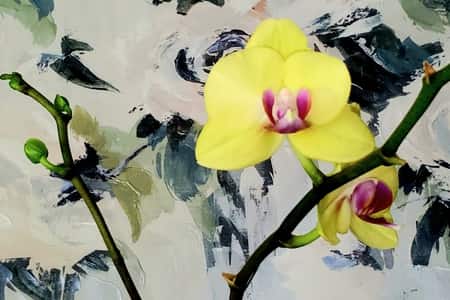
If the leaves turn sickly yellow, they’re getting too much sun. If they’re getting dark green (which I think is particularly pretty), there isn’t enough light. Move your orchids and test their locations until they are a healthy grass-green color.
If you have to grow lights, as I do, keep them far enough away from the light that you see a faint shadow over them when you place your hand in the light’s path. The shadow should not be too defined but very fuzzy and hardly visible.
If you have a lamp that measures in foot candles (FC), buy a set-up for 1000-1200 FC. The maximum would be 1500 FC, but that’s pushing the limit. If you’re using fluorescents, aim for two 4 foot 40W fluorescent tubes feet away from your plants.
2. Beginner Phalaenopsis Orchid Care: Watering
Aha! This is where most new orchid growers make it or break it—watering your Phalaenopsis orchid.
First, let me warn you NOT to water with ICE CUBES! I know the directions might say that but just don’t. Orchids are tropical plants and need lukewarm water. Ice cubes don’t hydrate the potting medium and provoke dehydration in the long run. You’ll see big brand name orchids that indicate the use of ice cubes, but even though the temperature is a bit cold as the water trickles down, it’s not enough to hydrate the entire potting medium.
I have a whole article on why NOT to use ice cubes and why the company decided to go with that advice, but just don’t do it. The ice will shock the roots. Take your Phal to the sink and open the tap water to a lukewarm temperature.
Remember, these are tropical orchids.
When I lived in Brazil, the rain came down like hot tea, evaporating when it hit the dark asphalt. Don’t shock your orchids with cold water, and don’t use ice cubes, no matter what expert advice you have received. Ice cubes don’t hydrate the potting medium and provoke dehydration in the long run. You’ll see big brand-name orchids that indicate the use of ice cubes, but even though the temperature is a bit cold as the water trickles down, it’s not enough to hydrate the entire potting medium.
Take your orchid to the sink and run water over the bark, turning the pot several times so water gets to all the areas inside. Keep the water running until it flows out the bottom of the pot. Let it drain a bit, then repeat the process. You can keep the water running, but that’s a lot of wasted water.
Don’t water the leaves or the crown of the orchid. Never do this.
Water can pool up inside the leaves and provoke bacteria, mold, fungus, and all other little microorganisms that complicate our lives as new beginner orchid growers. All these lead to one outcome: crown rot. Your orchid will star to have black spots, then a huge black splotch will take over your plant. Crown rot will kill your orchid, and it will do it quickly.
Orchids don’t like to be wet all the time. Let me rephrase that: Phalaenopsis don’t like to be wet all the time. Moth orchids need to have time for their roots to dry out in between waterings.
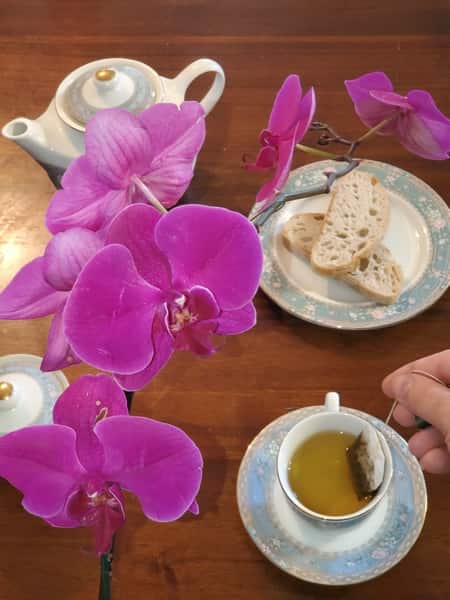
Go back mentally to the rainforest scene. It rains. But there is no soil to soak up the rain. The roots absorb what they can, but soon the hot air currents move swiftly through the trees.
Their roots dry out, and then it rains again. They have adapted to being dry and wet, but they are never dry or wet all the time.
This same phenomenon of wetness and dryness is harder to achieve in a pot. That is why the potting medium is not soil, but we’ll get to that in a minute. The idea is to water when the orchid is dry on the top part of the pot, but still a bit humid on the bottom. Never let a phal to totally dry up, and crinkle.
(Yet if you had to pick the worst odd, overwatering kills more than occasionally forgetting to water. There’s a saying that orchids grow better when they’re neglected. I’m afraid I have to disagree, but providing too much water, too much fertilizer, too much light, and too much Tender Loving Care can,, in fact,, hurt your orchid more than help it.)
For starters, water once a week. If you have a miniature phalaenopsis, water once every four days. With your finger, check the potting medium. It should be dry on top and humid toward the middle. If you’re uncomfortable using your finger, use a pencil or popsicle stick—anything that will show you how humid it is inside the pot.
If you’re in doubt, wait a day and check again.
It’s always better to underwater than over-water an orchid. After your moth orchid has bloomed and the flowers have all fallen off, the orchid will not enter a small period of dormancy like other orchids. Don’t water as much as you watered before since the orchid will not use the same water requirements. It will just sit in the potting medium, waiting to do something it shouldn’t do, like cause root rot. As soon as you see new roots, you can start watering to the normal levels you used to.
Keep in mind, too, that the bigger the pot, the more it will retain water. The smaller the pot, the more you’ll need to water. Adult phalaenopsis usually has an 8-inch pot (20 cm pot). I have several miniature phalaenopsis in 2-inch pots (5 cm pots), and I water them every four days since their pots are incredibly tiny (which makes them preciously cute, in my opinion).
So watering is a special care you’ll have to figure out as you grow your orchid. How dry is your home? How much light does your orchid get? How hot is the room that your orchid sits in? All these will directly influence how much and how often you water.
Don’t buy the generic rule that most orchid growers push off: water once a week and you’re good. It doesn’t work. Start with once a week and keep an eye on your plant. Adjust and tweak as necessary to get the best watering conditions for your Phalaenopsis.
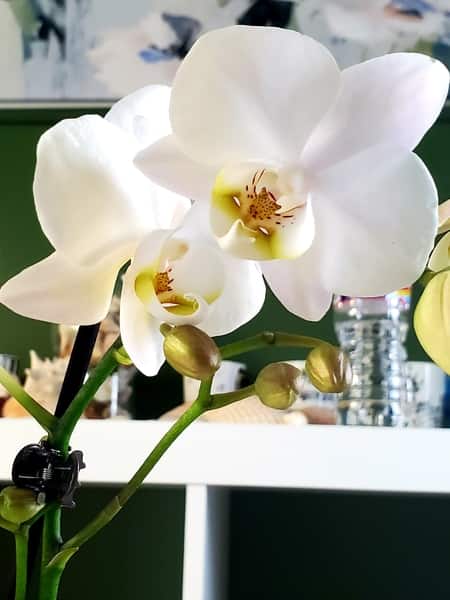
3. Beginner Phalaenopsis Orchid Care: Potting Medium
Phalaenopsis orchids have thicker roots, which absorb the water well. They also prefer to be humid but dry out fast, as mentioned before. So, the potting medium has to be special for this. Never use organic soil. Orchids don’t grow on the ground, and soil will smother them. They need air and water to run freely around their roots.
Commonly used potting medium for orchids are charcoal, fir bark, perlite, leca pebbles, Styrofoam, and sphagnum moss. Mix all this up together. Or you can buy potting mixes already pre-made. In this case, check for a coarse-grade bark, compared to a finer grade.
Fine-grade bark is used for orchids with thin, tiny roots. Phalaenopsis have thick roots, needing a thicker component to “grasp” while they’re in the pot. If you have a miniature Phalaenopsis, then you can use sphagnum moss with a finer grade bark, since the roots are more delicate and finer.
Whatever you do, don’t use soil. The main objective in using a potting medium is to provide air circulation around the roots.
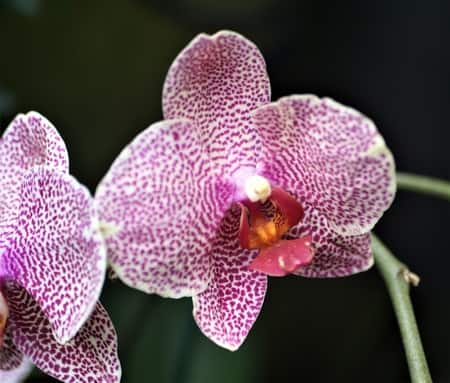
4. Beginner Phalaenopsis Orchid Care: Humidity
And we come to the final tip, and often, the most overlooked tip. Many people think that watering and humidity are the same thing. They aren’t. Humidity is how much water is concentrated in the air around your orchid. Inside our homes, the relative humidity (rH) barely reaches 33%. Most homes are around 25%.
This means you’ll have to find a way to raise the humidity levels in your house. You can use a damp towel that you moisten every night and hang up to air dry. You can use a humidity tray under your orchid. You can group plants to raise overall humidity in one location. A humidifier is best. Whatever you do, you must keep your orchid in a more humid environment than our homes provide.
Some orchids thrive in near 100% relative humidity, but not Phals. They like around 50% to 60% relative humidity.
There is an old wise tale that says Phals will have one leaf for every percentage of humidity that they live in. Not sure if this is proven or not, but since they usually have 4 to 5 leaves, this seems to be true. Lower the humidity, and the leaves will crumple, wrinkle, and eventually wither away.
Beginner orchid growers also like to place their orchids in the bathroom because that’s the first humid place that comes to mind. I specifically don’t recommend this because the bathroom rarely gets enough good light. Phalaenopsis like 12-14 hours of light a day during winter, and during summer, 14-16 hours. Unless you keep your lights on all the time in the bathroom or there is a huge window that allows for ample lighting, avoid the bathroom.
Another tip about the bathroom: yes, it’s humid. But the humidity levels fluctuate greatly. Unless you have eight kids and are always using the shower or bathtub, then the humidity is only high for about ten to twenty minutes a day. And let’s not forget the temperature fluctuations.
Orchids are slow growers, but they like to have constant conditions. The same temperature, constant lighting, regular humidity percentages, and so on. The irregular fluctuation of highs and lows are not good for orchid growing. Getting a Phalaenopsis to rebloom would be hard under these changing, irregular conditions.
5. Beginner Phalaenopsis Orchid Care: Fertilizer
With any orchid fertilizer, you’ll want to use ¼ of the recommended dose for Phalaenopsis. This is because most fertilizers are recommended for fast-growing plants. These household plants are rapidly producing new leaves, flowers, and roots.
Orchids, on the other hand, are here to enjoy the ride. They take their time—no pressure—one day at a time. These slow-growing plants don’t need a lot of fertilizer, and if you use the recommended dose on the fertilizer label, not only will you be wasting your product, but you’ll also be encouraging root burn from the salt build-up.
Each component in the N-P-K ratio is geared for a specific part of the orchid: roots, blossoming, and protection against infections (or overall health, if you prefer that term). At your local garden shop, check out the fertilizers that are available for you.
As for how much to use and how often to fertilize, most orchid growers like to add a little bit every week. The saying goes, fertilize “weekly, weakly”. I don’t, since I think this is way too much. I aim for every other week, but this is something that you’ll have to verify with your Phalaenopsis. It also depends on the quality of your water.
Hard water, soft water… The additives cities put in the local water supply can greatly influence how often you should use fertilizer (and water, too, for that matter). Always water the plant first because if you apply fertilizer straight onto the roots, it will cause root burn.
Fertilizing does change during the year, too. During summer months, you’ll need to fertilize more: once every other week. During winter, orchid growth diminishes a bit, so aim for once every three weeks or once a month.
My Phalaenopsis orchid flowers have fallen off. Now what?
Why did my Phalaenopsis orchid die? Your orchid is not dead but needs some time to recuperate from the active energy that it took to produce the flower spike and blossom.
Phalaenopsis orchids will enter a tiny period of dormancy—so tiny that it’s hardly considered dormancy. In fact, it’s technically not dormancy. The leaves should remain the same color and consistency, so if they are changing colors, there’s something wrong.
Once the orchid produces new roots from the sides of the stem, it’s time to repot and start watering and fertilizing again.
As for the flower spike, you can do two things. 1) you can cut it halfway back and encourage a new bloom, or 2) you can cut it all the way back and encourage new root growth. If you are going for the second option, leave the spike on as long as you can (or is visually appealing) and then cut it back. The orchid reabsorbs nutrients from the spike, so they aren’t wasted.
After you cut the flower spike on your moth orchid, apply cinnamon to the cut. This makes for a natural barrier that also acts as a barrier for bacteria, fungus, virus, and all those little creatures who also love orchids.

Are moth orchids endangered?
Moth orchids are not endangered anymore due to the mass production of both popular and rare species of Phalaenopsis orchids in nurseries.
Yet, this was not always the case. Moth orchids have adapted and grown in the wild for centuries. Before the Wardian Cases were discovered to be an efficient way to transport orchids overseas for long periods (a Wardian case is a terrarium with a loose-fitting lid that creates its own mini-ecosystem), moth orchids were limited to their natural habitats in tropical and subtropical climates.
Once Phalaenopsis orchids were introduced in Europe, the orchid hunt began placing the Phalaenopsis in danger of becoming extinct. Many explorers would venture overseas to find rare and undocumented orchids, creating a hazard for the orchids grown in the wild.
Once they found a species they liked, they would take all the specimens, stripping the tree of the entire orchid cultivation. During this period, many orchids vanished from the tropical rainforests. This was especially true of the Cattleya orchid in the plains of Brazil.
Laws and legislation have been put in place so that orchids would not go extinct. This was useful back in the day, but now, since orchids cultivators have successfully found methods to mass reproduce orchids from seeds in petri dishes, this is no longer necessary.
When do Phalaenopsis have to be repoted?
Every two to three years, you need to change the potting medium in your Phalaenopsis orchid. It would be best if you changed it the first time you get home with it, so you can mark a specific date they were changed and accompany their growth from there.
Also, you don’t know how the store potted your orchid. Usually they use the worst quality ingredients since they are produced in mass. You also need to take a look at the roots to see how they are doing. Many roots problems show early signs that they need repotting and you can prevent the potting mix from breaking down, promoting root rot.
Do Moth Orchids Need Clear Pots?
When you are repotting Phalaenopsis orchid, you need to decide which pot it will grow in for the next two years. All moth orchids have roots that photosynthesize, which means they need clear pots to receive the light.
Clear, plastic pots are the best for moth orchids to grow healthy roots. They allow the sun to penetrate the side of the pots, and since the potting medium is poor in nutrients, the roots can capture extra light through the roots.
In nature, all Phalaenopsis roots are areal roots since none of the roots where buried in the ground. If you want to read more about areal roots on Phalaenopsis, this article gives a good explanation that is more in-depth than what I’m writing here. In essence, the roots need to be in clear pots, since photosynthesis occurs.
The pot also needs to have slits or holes so air can freely move in and out of the potting medium. In the wild, a light current would make its way through the rainforest, and the roots would dry out after the heavy rains.
To recreate this same environment, you need to choose clear, plastic pots for your Phalaenopsis orchid. This other article also explains more about pots, and gives some ideas about terracotta pots, glass vases, and other kinds of pots that your Phalaenopsis might like.
Are Moth Orchids Edible?
Even though all orchids are edible, moth orchids do not enhance culinary with tasty blossoms. Dendrobiums and Epidendrums are more suitable in the kitchen. If you are interested in more culinary tips and secrets of how to add orchids to your daily cooking, check out this article about adding orchids to recipes.
Don’t Stop Learning!
If you want to be included in more information and get a 14-page fertilization guide, please sign up for my newsletter. I don’t spam, but send emails out bi-monthly with some curious topics of interest. If you want more information, click here to go to a specific page on this website where I explain it more in detail.

Also, if you are looking for an orchid journal to keep your notes specifically about orchid care, check out my 2 solutions for that on this page. If note-keeping isn’t your thing, then there is a free excel spreadsheet that you can download. Click here for more information on how to do that.
If you subscribe to my newsletter, I will send you a 14-page guide on the main tips of orchid fertilizer. It is downloadable and you can print it out on your computer. I designed the guide to double up as a coloring book, just to make it fun.
Can Phalaenopsis Orchid Grow Outside?
Phalaenopsis orchids can grow outside depending on where you live. After all, they were outside dwellers long before humans came along and stripped them from the trees. When I lived in Brazil, orchids grew without any care form my part. They just blossomed off the trees and in the shrubs around my house.
Now that I’m in Kansas, the story is a bit different. By the way, if you want to check out my life’s story, just so you know who’s writing these articles, I have an author page you can read. I’ve written a heart-wrenching memoir about my time in Brazil and getting back home to the USA, which wasn’t easy.
Anyway, back to the Phalaenopsis growing outside…
If you have a climate that is similar to the natural habitat of the Phalaenopsis, then you most certainly can grow your orchid outside.
What does this mean exactly? Phalaenopsis orchids like to have a high humidity, as you’ve already read. They also need to be in a temperature that doesn’t get too cold at night (frost-free) or to hot during the day. This means that the maximum temperature that your orchid can still thrive is nothing above 85 F (29.4 C), and you have to measure this at the hottest part of the day during the summer. During the cooler winter months, at night, the temperature shouldn’t drop below 50 F (10 C).
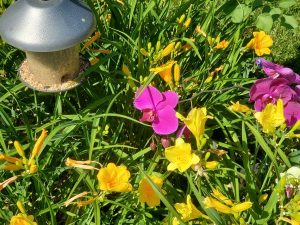
All Rights Reserved
Unfortunately, that eliminates a good part of the continental United States. A few states can get away with those circumstances, without a greenhouse.
You can bring your Phalaenopsis orchid outside during spring and fall, always watching that the leaves don’t get direct sunlight during the day. Early morning sun and late evening sun are recommended, but nothing else.
Now that you know the basics of growing Phalaenopsis and moth orchid care, you can easily adapt these tips to your environment and habits. Each of these “mini-guides” written here, have longer articles and more in-depth explanations that you can link to if you want more information.
I hope this guide helped. If you have any additional questions, you can type them down below or check out my website, since I have over 200 articles of orchid-related material just for beginners. If you want visual inspiration, check out my Pinterest page or follow me on Instagram, where you can find thousands of pictures of orchids, ideas on how to make an orchid floral design with phalaenopsis, and much, much more.
Happy Cultivating!


The article content seems to be missing. 😅 I’d love to read your guide.
Justine,
Oh, my gosh!!! I just opened the page and it’s gone! I’m going to look into the tech part of it and see what happened. Thank you for pointing it out. Just so you know, that was a 3,800-word article. Yikes! But honestly, thank you for mentioning this. I’ll see what happened and get back to you.
-Amanda
Hi Justine,
I think I got the content back up and visible so you can see it. Tech is not my strong point. Again, thanks for the comment. I appreciate it.
-Amanda
Thank you for the detailed guide. I enjoyed reading it.
I have a Phalaenopsis Orchid. I have had her for 3 years. She looks healthy, has firm, fat roots. She flowered this summer, I cut the flower spike down to the first green node and she is sending out two new flower spikes.
I set her into a container of water for a few minutes once a week, and drain the water completely. I add a little orchid food once month. This week I noticed what looks like small white “Non-pareil candy” like spots in the medium. (course bark). They rub off easily, could this be salt build up? I am on an artesian well.
She is in a ceramic Orchid pot with cut outs in the sides. She has sent out many roots threw the holes, so re-potting would damage them.
Her name is Snow White. She was given to me when my Son passed away and is very special to me.
Can you tell me what to do to care for her?
Hi Lesley,
I’m so sorry to hear about your loss. I know how orchids can be very representative of the people we love. I got into orchids because of my mother and now she isn’t here to teach me, so I hear your pain. My heart is with you.
It doesn’t seem to be mineral build up. It could be one of these four little critters, cited int his article: https://orchideria.com/orchid-mold/ or even one of these critters, noted for living in bark: https://orchideria.com/orchid-bark-bugs/
Those 2 articles should help. Take Care,
Amanda
I recently purchased a orchard from Krogers, got it home only to find there are small, white bugs on the leaves which leave a sticy residue along the edges of the leaves. Are these aphids? I washed them off with baby soap and water and dried the leaves very carefully with a clean cloth. Did I do the right thing? I have 10 orchids and love them all so I am now I am afraid of bugs spreading on the others.
PS Through the use of hormone, I think two of my plants are pregnant, for lack of a better term. How long will it take for the kekie to be big enough to plant seperately. They are very tiny nubs right now, but make me so happy!
Once all the flowers have fallen off, do you continue to water, what do you do where the flowers bloomed. I know they are on the stem, do you cut it off, or will another grow somewhere on the base of the plant?
Once all the flowers have fallen off, do you continue to water, what do you do where the flowers bloomed. I know they are on the stem, do you cut it off, or will another grow somewhere on the base of the plant? i ask once before and never got an answer.
After 18 months my Phalaenopsis is blooming. It would have probably bloomed sooner with your information (I found you MUCH later). I wish I could post a photo.
How can I make their leaf look shiny?
Hi Jham,
There is an article on my site where I talk about that. https://orchideria.com/clean-orchid-leaves/ I hope it helps!
Hi Amanda,
I see in the pictures in this article the orchids are placed into nice ornamental pots. I also did that with my orchid. What about the roots not getting light? Should I just leave it in the plastic pot it came in? Thanks
Hi Annette,
I would remove the pot if you are a new orchid grower. Transparent clear vases with holes in them are the best. You can place them in ornamental ceramic ports when they are in bloom to showcase them as a centerpeice, but otherwise, it’s best for their roots to have that air circulation.
-Amanda